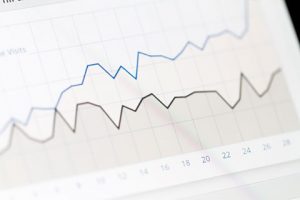Since releasing his latest book, “Jerk: Twelve Steps to Rule the World,” Christopher Surdak has spoken with thousands of business and governmental leaders about Big Data, Analytics and Digital Transformation. With this experience, he tries to answer in this article, all the important questions revolving how central banks struggle with digital disruption.
Do any of these sound familiar to you:
“I need to monetise my data.”
“How do I get value from my analytics efforts?”
“My data scientist finds lots of interesting relationships, now what?”
“How will Hadoop increase my revenues?”
“Why don’t my forecasts and models work anymore?”
If so, you’re not alone. Since releasing my latest book, “Jerk”, earlier this year I have spoken with thousands of business and governmental leaders about Big Data, Analytics and Digital Transformation. From startups to Fortune 50 goliaths, from government agencies across the world, to global NGO’s such as the World Bank, everyone is struggling to figure out how to better put data to use, while they still have time.
Many organisations have invested heavily in Big Data technology, deploying a virtual “Noah’s Ark” of new software tools such as Hadoop, Hive, Pig, Impala and so on. Each new tool attempts to address the shortcomings of its predecessors, and the Big Data ecosystem is evolving very rapidly. Perhaps it is no surprise that the open source group Apache has created a software platform called Zookeeper to help manage this growing herd of software tools. This rapid evolution, combined with the enormous hype around Big Data, is driving many organisations to build expansive Big Data platforms. These initiatives are loaded with potential, but frequently short in actual business value.
[ms-protect-content id=”9932″]
Insights Aren’t Enough
A consistent theme in all of the conversations I have had with executives has been the gap between Big Data’s theoretical promise and its operational reality. We are engulfed with the message that we must embrace Big Data in order to survive, yet few organisations seem to gain actual business benefits from their Big Data investments. I would argue that the recent shift in focus from “Big Data” to “Digital Transformation” is a direct result of this trend.
In most cases, this shouldn’t come as a surprise. Many are simply doing the same analyses they’ve always done, only faster, cheaper or with more data than before. While incremental improvement has been a canon of business management for the last 20 years, it is clearly not a path for breakthrough results.
Some organisations actually gain new insights by analysing new sources of data, but they also find that it’s difficult to benefit from their efforts. In these cases, organisations haven’t changed how they operate to take advantage of these insights. Organisations must be able to act at their new speed of insight, otherwise the insights will only be a source of frustration; and frustration is a common theme in Big Data discussions. IT departments have learned how to build new analytics platforms to answer entirely new questions in entirely new ways, but they do not know what questions to ask. Conversely, business and operations people know that they need to work in new and different ways, and they often know what questions need to be answered. However, business people may not know what questions are answerable, or what it takes to get there.
This dynamic has existed for decades, and it is nothing new to information technology professionals. Deploying technology-based business solutions often feels like attending a first dance at a middle school; the young women line one wall of the gymnasium, the young men the opposite wall, while music drones over an empty dance floor. Both groups want to interact with the other in order to enjoy each other’s company. But, each enters the event with completely different perspectives, fears, wants and expectations, leading to less-than-optimal results. Over time, the music has changed from A Flock of Seagulls to Nirvana to Lady Gaga, and the technology has changed from Lotus Notes to Java to Python. But, the theme of IT-doesn’t-play-well-with-the-business has remained regrettably consistent for decades.
Experimentation Changes the Experiment
I recently came across a speech by Janet Yellen, Chair of the Board of Governors of the United States Federal Reserve which shows that organisations of all shapes and sizes are struggling to adapt to a changing world.1 Yellen spoke about America’s continuing efforts to recover from the “Great Recession” of 2008. Like central banks around the world, The Fed has tried to use its financial levers to return the world economy to steady, stable, predictable growth.
This has proven much more difficult to achieve than anticipated. Despite implementing historically-loose fiscal policies, the global economy remains in a funk. Indeed, many central banks have actually implemented negative interest rates in the hope that this would push more money into circulation. Despite these efforts (arguably the very definition of anti-capitalism) economic growth seems elusive. As Yellen pondered the reasons that global central bank policies have fallen short of expectations, she posed four questions to the assembled audience of economists, bankers, bureaucrats and policy wonks.
From the perspective of a data analyst, I found these questions fascinating as they indicate both where The Fed needs to find new answers, and how Big Data and Digital Transformation might lead to them. Let’s look at her questions in turn, from a Big Data perspective.
Question 1: “Are there circumstances in which changes in aggregate demand can have an appreciable, persistent effect on aggregate supply?”
Yellen postulated that most economists would historically answer “no” to this question. However, evidence since 2007 tend to suggest that lower aggregate demand may suppress aggregate supply. For data scientists the operative words here are “aggregate”, “suggest” and “may”. As an analyst, I love these words because they indicate areas where modest improvements in data and math might completely change existing understanding and dogma.
The opportunity here is to find and use much more detailed data to disaggregate the relationships that are currently estimates. Supposed correlations often fail once more and better data becomes available. Supposed causation is even more likely to fail under the greater scrutiny provided by zettabytes of actual data. For Fed analysts, detailed data on actual purchase behaviours might shift both economists’ understanding of supply and demand and the financial tools used to manage the economy.
Question 2: “…whether individual differences within broad groups of actors in the economy can influence aggregate economic outcomes – in particular, what effect does such heterogeneity have on aggregate demand?”
If Yellen’s question here seems rhetorical, it’s likely because it is. As anyone who logs into Amazon, eBay or Facebook knows, every broad group of actors in a population is actually made up of people who frequently think or act across a broad spectrum. As recently as 10 years ago, advertisers might talk in broad terms like “Millennials”, “Hispanics”, or “middle-class, middle-aged, male professionals” when they try to characterise customers or market segments. Increasingly, such broad categorisation is suicidal for businesses, as people now expect deep personalisation and independence.
Digital businesses work to understand each individual as an individual. They realise that using averages to address customer needs gives outliers a disproportionate impact on outcomes. They seek to understand the under-served ends of each population’s distribution; what I call the Hightail and Lowtail in “Jerk”. In this case, The Fed may do well to look at how digital masters such as Netflix or Starbucks use deeply intimate and personalised data to better understand the outliers in populations, and how these players may have outsized effects on their peers.
Question 3: How does the financial sector interact with the broader economy?
Implicit in this question is the notion that The Fed has less control over economic conditions than previously believed. In response to the financial crisis of 2008 The Fed cut the prime interest rate to near zero. It also started to pay interest on reserve deposits, bought banks’ assets (such as mortgages) to prop them up, and became more explicit in its forward guidance on interest rates. Despite these steps, the recovery has been weaker than expected. New policy tools were required to impact the broader economy, which implies that there have been fundamental changes to how our economy now operates, versus 10, 20 or 50 years ago.2
How the global economy develops in the future, and what control the financial sector will have over this development are key questions for central banks, governments and businesses world-wide. If existing controls continue to fall short what new tools will be required to drive predictable growth? If central banks use new policy tools to generate desired results, are those results likely to occur? If these approaches are supported by the same data and analyses that fell short over the last eight years, one wonders how effective they may be.
This is where Big Data may apply to this question. These new approaches, tools, policies and stimuli will be applied in new ways to address unforeseen problems. This means a great deal of uncertainty and risk. Unless new data and new models are used to assess these new policy tools, how likely are they to succeed? The relative shortcomings of existing tools imply that we don’t fully understand what is driving current economic conditions. Introducing additional variables into our existing equations may lead to even greater unintended consequences. We will need to extensively model the impact of new fiscal policies, and monitor their impact on the economy, to determine exactly how much control the financial sector maintains over the global economy.3
Question 4: “What determines inflation?”
 Yellen’s final question in her presentation may further demonstrate the need for new tools, new data and new analysis. Controlling inflation is one of the core missions of The Fed. So, for the chair of The Fed to ask what determines inflation is an explicit admission that the world has changed and we need to ask new questions.
Yellen’s final question in her presentation may further demonstrate the need for new tools, new data and new analysis. Controlling inflation is one of the core missions of The Fed. So, for the chair of The Fed to ask what determines inflation is an explicit admission that the world has changed and we need to ask new questions.
In her speech, Yellen gave a range of economic assumptions that require added scrutiny, including the impact that present policy statements have on future behaviours. This sounds remarkably similar to predictive analytics performed by digitally-savvy insurance companies, e-tailers, and social media advertisers. Such analyses are core to contemporary Big Data practices, although in the case of The Fed “Big Data” may have to become “Humungous Data”, given the scope of these questions, and the potential implications of their answers.
Micro Principles, Macro Scale
Reflecting on Chairwoman Yellen’s questions I find the same concerns that I hear in speaking with leaders of every organisation; although scaled up rather dramatically. The same old analyses of the same old data, using the same old interpretations and biases are no longer leading to the same results. Instead, many attempts at applying traditional business thinking either falls short of expectations, or leads to completely new, and undesirable, results.
This shouldn’t be a surprise. Rather, the decreasing effectiveness of our reporting and controls is a direct consequence of our success in managing what is known. The better we are at managing these knowns, the more likely we are to be impacted by unknowns. To maintain some control over our environment, we must ask new questions of new data. To expand our understanding of our businesses, our economy and our world we must recognise that our attempts at prediction and control change the very things that we are trying to control. And, the more we believe we have achieved control the more disruption we are likely to feel once we realise things have changed.
Like central banks around the world, The Fed has many challenges ahead. Our economy is behaving in unexpected ways not because our policies are off. Rather, we are experiencing a global social change brought about by the Digital Trinity of Mobility, Social Media and Analytics, which changes the rules of how our economy operates.4
As Albert Einstein once said, “We can’t solve today’s problems with the same thinking that created them.” And this is the essence of Big Data. Regardless of whether you’re analysing clickstreams, Facebook posts or macroeconomic trends, to understand our rapidly changing world you must ask new questions of new data. In each case the answers are out there, waiting to be discovered.
[/ms-protect-content]About the Author
 Christopher Surdak is an Engineer, Juris Doctor, Strategist, Tech Evangelist, 2015 Benjamin Franklin Innovator of the Year, and Honored Consultant to the FutureTrek Community, Beijing, China. He has recently launched his own consultancy firm Surdak & Company. His latest book is Jerk: Twelve Steps to Rule the World. He is also the author of Data Crush: How the Information Tidal Wave is Driving New Business Opportunities, which is GetAbstract’s International Book of the Year for 2014.
Christopher Surdak is an Engineer, Juris Doctor, Strategist, Tech Evangelist, 2015 Benjamin Franklin Innovator of the Year, and Honored Consultant to the FutureTrek Community, Beijing, China. He has recently launched his own consultancy firm Surdak & Company. His latest book is Jerk: Twelve Steps to Rule the World. He is also the author of Data Crush: How the Information Tidal Wave is Driving New Business Opportunities, which is GetAbstract’s International Book of the Year for 2014.
References
1. “The Elusive ‘Great Recovery”, 60th Annual Economic Conference, October 14, 2016, Board of Governors of the Federal Reserve System, https://www.federalreserve.gov/newsevents/speech/yellen20161014a.htm
2. “The Federal Reserve’s Monetary Policy Toolkit”, August 26, 2016, Board of Governors of the Federal Reserve System, http://www.federalreserve.gov/newsevents/speech/yellen20160826a.htm
3. “What are the Federal Reserve’s objectives in conducting monetary policy?” Board of Governors of the Federal Reserve System, https://www.federalreserve.gov/faqs/money_12848.htm
4. World Economic Outlook, 2016, International Monetary Fund, http://www.imf.org/external/pubs/ft/weo/2016/02/




































